#not a bird expert at all but maybe a great black backed gull?
Text
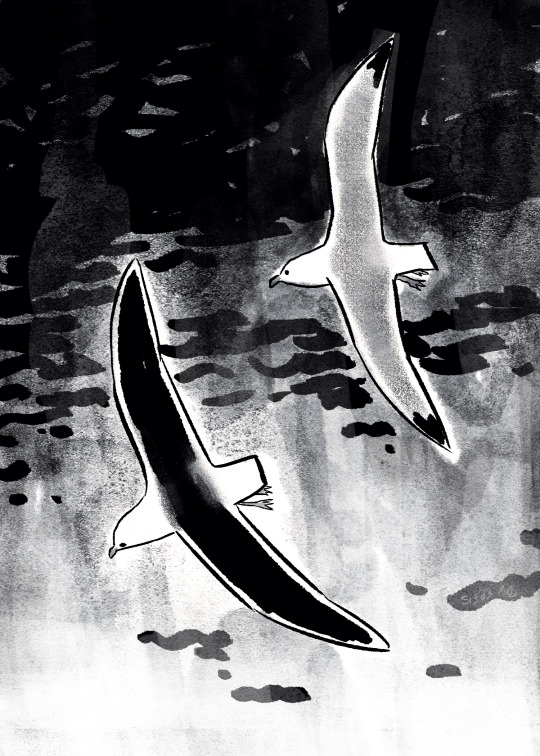
saw a seagull that looked different
#sketchbook stuff#artists on tumblr#usually the ones that look like the right don't think I've seen the left one before#not a bird expert at all but maybe a great black backed gull?#the wings looked like it plus they can be found where I live but idk gfhf#little break doodle#also guess who was like ehh I'll buy totk at some point but then ordered digital the day after it came out lmao#also there's a tiny rainbow in the clouds#edit: oh my god I'm dumbass I mixed up my left and right AJGS#the left one's the one I haven't seen before
3K notes
·
View notes
Photo
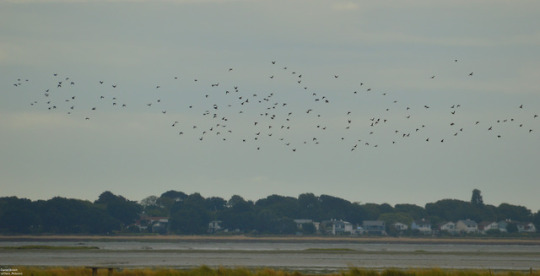
20/08/18-Whinchat and more at Farlington Marshes
In what should be the last clearance of a bit of a picture and blog backlog this is the post about an impromptu trip to Farlington yesterday. With the Bird Fair posts I decided to not have a day’s blog posted the same night as a day’s photos were tweeted on Dans_Pictures as its a large amount of photos going onto Twitter at once and obviously the people who may pick up the links to my Tumblr posts generated when I do a post are a big part of my blog audience so I did not want to overload you too much. Therefore I am writing this yesterday so it reads like that.
So today amongst all the jobs to do at home after returning from Rutland and the project that is getting my Bird Fair pictures and blogs processed, finalised and posted which I made good progress on last night and this morning, I had time to head out to Farlington Marshes with a Cattle Egret reported there. We didn’t see the Cattle Egret on what was quite a gloomy affair, shown well by the only picture I took today attached to this photoset of the Starlings gathering. Its interesting I saw this behaviour which I associate with autumn today as yesterday at the Bird Fair during the ‘Ask The Experts’ piece Dominic Couzens enlightened us that a murmuration of Starlings basically can refer to any multiple gathering of them so whilst I’d usually be careful about using this word for a gathering like I saw its technically correct.
There was one bird I did need for my year list which my Mum had seen here this year already and I saw here last year, the Whinchat, and when walking round to the area we’d seen them in I was delighted to see one fly along and up onto a bush. This was my 180th bird of the year, this year tick complimenting the Bird Fair three well to get me to this amazing milestone for only the third time in a year which I am so honoured to do. This puts me just 1 behind my second highest ever total in 2016 and 10 behind last year. I didn’t get to 180 last year until about a month maybe more later as Curlew Sandpiper at Farlington did this and was my last September 2017 year tick. So on how many birds I have seen day by day nothing can overtake my year list until October and its looking increasingly likely only my 2017 record year list is gonna be in a position to do so.
The first bird itself, we saw one or two more Whinchats today, had a really nice coloured breast and looked well. The species was one that always really excites me as its one of my big success stories of the last three years. I had seen one once and then again here in 2012 but since 2015 they’ve become a year list regular with more than one sighting in a year at times too and I have had some big experiences seeing them whilst gaining confidence in seeing them so at this time of year its always a quiet target of mine and always one I really enjoy seeing.
Wildlife Sightings Summary: My first Whinchat of the year, two of my favourite birds the Shelduck and Little Egret, Goldfinch, Linnet, Wren, Meadow Pipit, Whitethroat, Blackbird, Starling, Kestrel, Black-headed Gull, Great Black Backed Gull, Mallard, Moorhen, Canada Goose, Black-tailed Godwit, Redshank and Small Heath and Common Blue butterflies.
#farlington marshes#whinchat#starling#birds#birdwatching#august#gloomy#bird fair#hampshire#england#uk#earth#nature#world#beautiful#wonderful#day off#monday#wee#weekday#europe#wildlife#photography
1 note
·
View note
Text
Tuesday 29th December 2020
My Bird List Again. Parts 3 & 4
♦ outside links are indicated by bold type - none are affiliated to this blog

Guest Photograph - Two Jays out of the window in South London. I’m assured there were four but as is the way, two took off. Photo Credit: Ms NW tE
♦ Faces in Things. Now I’ve circled the Jays I can see a cartoon character with unruly hair. First thought was a cheeky Ostrich’s head, but Crow thinks he can see a cute Badger. Now I can see both.
Brought Forward 24 species
Yesterday I listed the every day birds in our garden and those we can guarantee to see most days, definitely every week, plus the new spots for this year. Next up is
GARDEN REGULARS:
These are the birds we see frequently but not necessarily every day or this time of year
Song Thrush

If you followed my Blog earlier in the year you’ll recall the calamitous tale of ‘Tracey’ who tried to nest in our porch, firstly on the top of - and with some gentle encouragement, later inside - the open fronted nest box. We called her Tracey after the artist best known for her ‘messy bed’ Sadly the nest came to nothing except a very watchable experience, but we have seen youngsters who if not from Tracy, someone else got it right this year.
Song Thrush are seen here most weeks but we can’t depend on it being so. What I could depend on through early Spring was that one had taken over from the Blackbird and was giving me wakeup calls from the very early hours. It’s annoying to be disturbed so early, but also kind of comforting to have your regulars out there making their presence known.
Wren
Strangely for such a cute little bird I don’t have anything much to say, certainly no personal stories. They’re around, but very low key. I know them best for their upturned tail and unfeasibly loud voice. Sorry no photo, must rectify that, this one’s from the WildlifeTrusts.org site
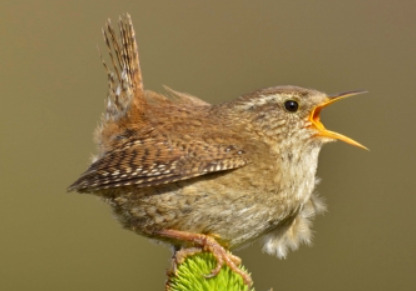
Stock Dove

Of all the birds I’ve ever seen the Stock Dove is the biggest revelation to me. Until I had my eyes replaced I thought they were plain monotone grey birds. When I could see properly WOW WOW WOW. They have so many tones, they’re so beautiful and the pink, emerald-jade and purple hues are outstanding when they catch the sunshine. This realisation is one of the most incredible sights of my life and both that initial memory and every new viewing always will be.
Collared Dove

One of the above is not a Collared Dove - nope, not buying it even if you have got your best collar on mate
To be fair, I almost put the Stock and Collared Doves in the every day/reliable category, but on balance I don’t think they’re quite there at this time of year. We do see them most days and the charming Collared ones always come in pairs - just like me and Crow.
Green Woodpecker
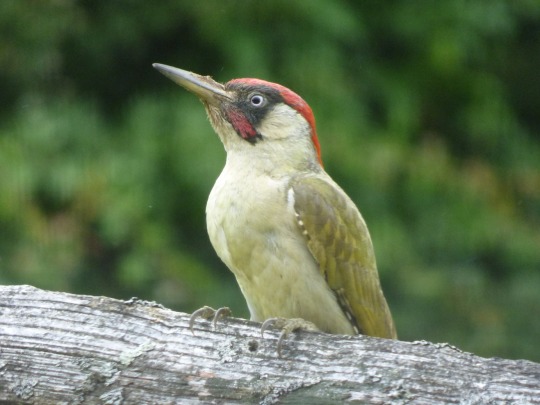
My ant-eaters. Not seen on the same basis as the Great Spotteds but they live here and breed successfully. Quite stately birds with beautiful plumage I love to see the brief flash of yellow underwing as they whizz through the garden and to hear their laughing ‘yaffle’
Similar to GSWs you can tell the sex by the red or plain black colouring. In the Greens it’s on the ‘moustache’ area - see male above with red: females have black. On the GSs it’s plain black heads for females and a red patch at the nape of the neck for males.
Magpie

Comical birds. We seem to have less here than we did. The most I’ve ever seen was a huge flock on the Common in Tunbridge Wells. It’s called the Common but it has the main road going through it and where I saw them was no more than a large patch of grass and trees. The other side is more typical common land, steep and heath-like.
One year we were highly entertained by garden resident DJ (after DJ Spoony) so called as he created a cache of goodies gathered from around the garden much like a Bower Bird decorates its nest. DJ just kept his treasures amongst the leaves at the base of the palm and included a plastic spoon that we used to put out cat food for the hedgehogs...it took us a while to locate.
Common Buzzard
This photo is from the field now known as Babs’ Field directly across the lane from our house. It’s a big field so this is a very long zoom. We saw a huge Buzzard down the lane just yesterday actually. A lot of sightings recently.

Goldfinch
A standing joke in our house - so, so hard for me to capture a picture of them they tormented me and then all of a sudden this Summer they started coming into the garden more and I got photos on fences, verges and wires down the lane too.
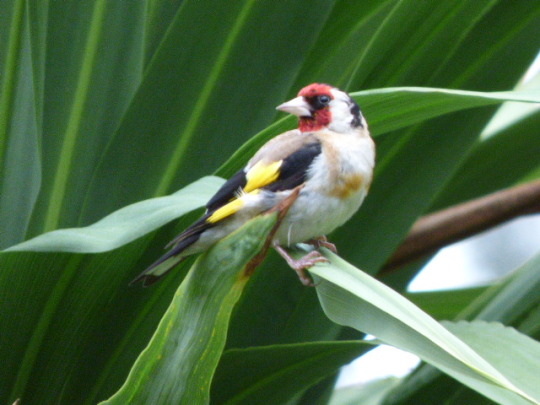
Pied Wagtail

Has bred in the porch nest box years ago, had two successful broods. We watched them fledge down on to the log pile. Favourite nestling was The Bunter - guess why? Maybe that was the one who grew up to be The Inspector patrolling the seed and shooing everyone away just because he could.
Grey Wagtail
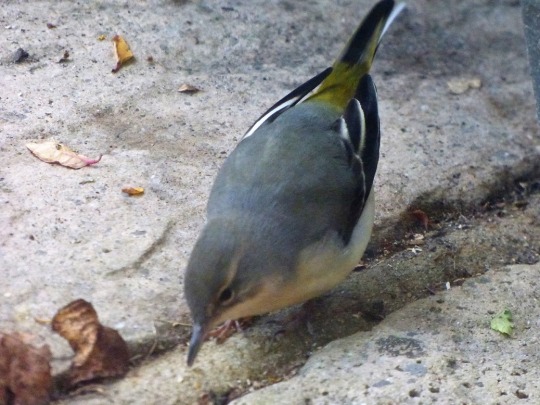
Usually flies in for a very quick drink and off again, or perches on the corner of the roof by our bedroom briefly.
Sparrowhawk

Nicknamed for both sexes is Sid (Vicious after the punk rock singer)
These two are males. We know their favourite places in the garden. On the fence between us and next door with an eye line to the feeders; on the posts around the decking, perched on a spade or on the bird bath.

Female below.
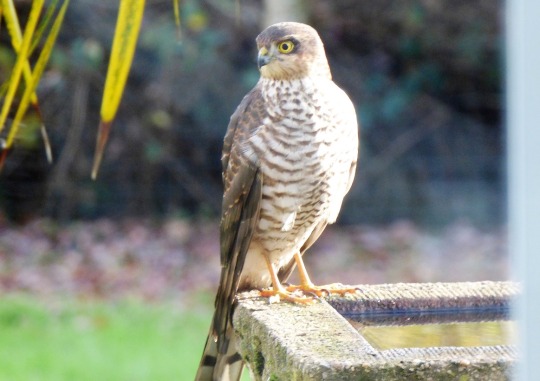
Total 11
INFREQUENT VISITORS:
Swallow
All around the local area, once very welcome guests and residents in our front porch.
I also once found one in Ms NW tE’s bedroom and had absolutely no idea how it could’ve got there. This was long before the nesting. I assume it must’ve found a way under the eaves where there’s a fitted wardrobe built in. It wasn’t panicking at all.

Swift
Sorry no picture, too high overhead. This one below courtesy of the Wildlife Trust site. Along with Swallows and Housemartins a lovely sign of Summer.

Greenfinch
A very welcome returner this year and they bred, which is brilliant news

Juvenile
Bullfinch
Sadly not seen any at all this year, which is unusual. Doesn’t mean they haven’t been and we’ve missed them though

Mistle Thrush
We have seen them, but no photos as yet.
I can’t tell the difference between a Song and Mistle Thrush, I ask for an expert ID. The RSPB says Mistle Thrush are
Medium-sized birds, they’re our largest thrush
Chunky and pot-bellied
Tawny brown and grey backs with a creamy white speckled front
Whiteish cheeks
Bold and bullish
and their song is somewhere between Song Thrush and Blackbird. That said we seem to have some Song Thrush here whose songs have evolved (as they do) This might help, although I think in real life it’s less clear cut. I obviously need more practice.
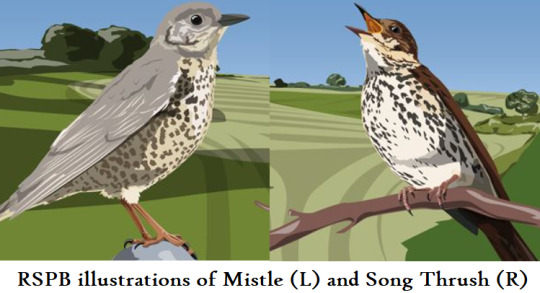
Jay

The Jay is so shy and has a fairly comical looking face. They live in the woods but we rarely see them in the garden and any photo is snatched very hurriedly, hence the quality of this one. They don’t need to come into the garden though as the woods are full of Oak trees and so their favourite food supply and places to cache it, is right there for them.
Kestrel
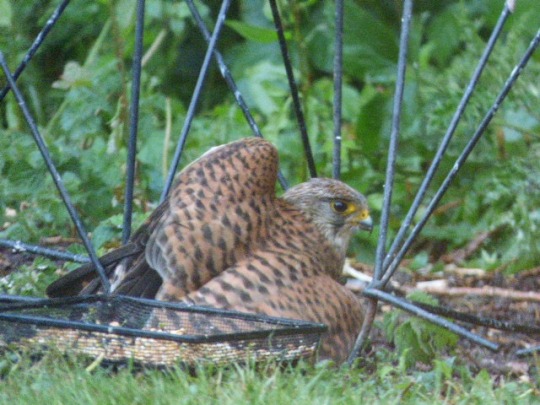
Usually seen up at the farm where we saw her a lot with her babies, this mother of two came into our garden in the Summer.
Common Gull

Rather unclear it was very low light inside the kitchen and this was grabbed with my phone. The last few days we have seen hundreds of Gulls: they’ve come inland to the fields due to the inclement weather I guess.
Nightingale
Definitely heard and confirmed by our neighbour and the local farmer, however, I can’t hand on heart say I’ve spotted them by eye. I think they should be included here though as we more than likely have seen them as well as heard them. I know where they hang out for sure and it’s steps away (see below) The problem for me is that they’re quite insignificant looking if you’re not primed to spot one.
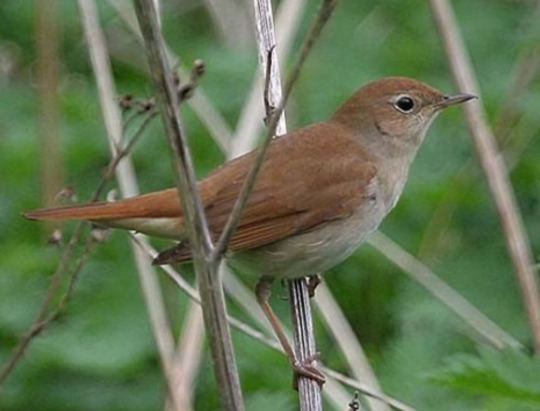
Photo credit Bird Guides on line
9
ONE OFFS IN THE GARDEN:
Mallard
Two males and a female decided to reside in our garden one summer. We called them Max, Paddy and Holy Mary - a Phoenix Nights reference from the TV series.

Heron
Occasionally seen overhead, has investigated our garden pond. Not that we’ve got any fish, which is why it probably hasn’t been back. We see them fly by sometimes and definitely up at the ponds. When the one was in our garden I was struck by its size and prehistoric look, of course they look much bigger in a domestic garden than when you see them in a wider setting.
Below is my own photo of a Heron, but at Richmond, not at our pond.

Turtle Dove
2006 was a good year. We had the Ducks and a few sightings of the Dove. I think it stopped by the following year too but can’t be absolutely sure.
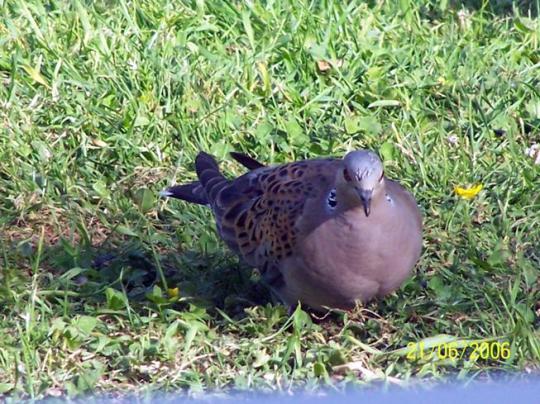
Yellowhammer 2014
Just the once on the patio right in front of us, it was quite a surprise.
This is not actually my photo, which is mislaid for now. It’s generic so can’t attribute it.
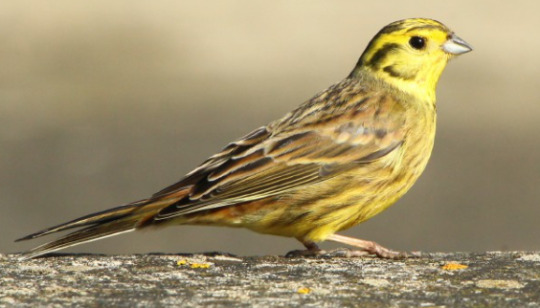
Woodcock 2019
The Woodcock was a complete shock. I spotted something out of the side window and because of the colouring thought it was a strange female Pheasant, until I saw its bill. Wooaaah!

5
ONE OFFS IN THE AREA:
Kingfisher down at the bridge
Mixed flock of Geese including White and Grey Lag - in Babs the Buzzard’s field
2

Sub Category just out of interest and not counted
REPORTED BY MY NEIGHBOUR:
Visual of a Cuckoo, which we’ve only heard and not seen for sure. We possibly saw one at the farm, but didn’t confirm for certain.
Goldcrest. I’m jealous
+ 2
REGULARS AT THE FARM:
Little Owl
White Dove
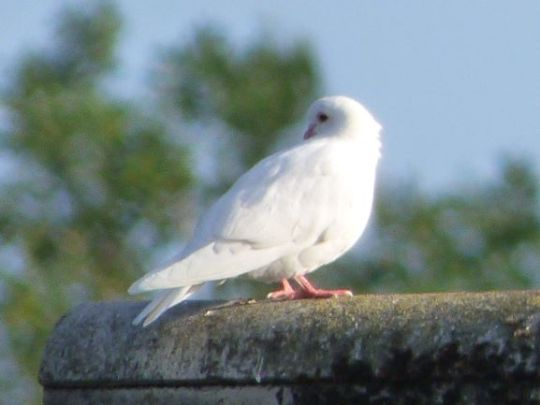
Coot
Moorhen
Canada Goose
Various Ducks such as Grebe, not including Mallard mentioned above
6+
TOTAL = 57+ species spotted at home and 2 others on the one off list seen adjacent to our garden.
Plus Tawny Owl, heard frequently but can’t promise to have a sighting as yet.
Decoration from the Christmas Trees in Standen Courtyard
a lovely hand stitched heart with wild flowers. Let’s hope the Roadside Verges campaign and sensible strimming season grows stronger next year.

Christmas Music of Choice is the Piano Guys
with a very clever Christmas medley and visuals
youtube
0 notes
Text
Cornwall is a paradise for birdwatching. The county’s position, stretching out into the Atlantic, surrounded by hundreds of miles of beautiful coastline, means that not only is it an ideal stopping off point for many migratory species but it often has unusual visitors. Birds that have been blown off course or over-shot their intended destination and end up staying in Cornwall for a while. Cornwall also boasts a milder climate than the rest of the UK and a surprisingly wide range of habitats – from high windswept cliffs to isolated moorland and lush farmland.
Below I have chosen what have been described as the best bird watching spots for both professionals and amateurs by Cornwall Birding and Cornwall Bird Watching and Preservation Society.
At this point I should add that despite the name of this blog I am not a bird expert! I am a bird lover however and so I have included a few of my own locations, places where I have been lucky enough to see Kingfishers, Choughs and a pair of Great Crested Grebe dancing.
Hayle Estuary
Hayle Estuary is the most south westerly estuary in the UK, a Site of Scientific Interest and an RSPB reserve. It is home to a wide variety of wetland birds including Oystercatchers, Curlew and Little Egret.
I am told that winter is one of the best times for birdwatching here, when you can see a large flocks of Teals and Wigeons and maybe even the odd vagrant Ring-billed Gull from North America.
Lizard Point
Much of the Lizard peninsula is an Area of Outstanding Natural Beauty and for good reason. There are several reserves here too including Goonhilly Downs. The Lizard Point is the most southerly point in Britain and is a stunning place for a walk with a good chance of sighting some unusual visitors.
In early 2019 a Black-browed Albatross paid a visit and importantly the area is home to one of the UK’s rarest birds – the Cornish Chough. Other sightings here include the odd passing Puffin and Razorbill, also Guillemot, Chiffchaff, Wagtail, Wheatear, Hen Harrier and Peregrine.
Argal Reservoir
Argal reservoir, and the nearby College reservoir, is one of my favourite places for a walk close to my home. A circuit of Argal lake is roughly 2.5 miles and there is a bird hide at the furthest end which offers great views across the water.
Well stocked with fish, the lake is also home to ducks, coots, moorhen, swans and lots of other visitors including Herons, Ergets, Great Chested Grebes, Teal, Canada Geese, Pochards and various gulls as well as many woodland birds.
Argal lake is very popular with dog walkers and fishermen and I find it is quietest early in the morning, at dusk and on rainy days.
Isles of Scilly
The incredible species list for this group of sub-tropical islands now stands at over four hundred. That is more than any other single site in Europe. Cornwall’s tiny archipelago is probably so popular with birds (and twitchers) because it is the first and last landfall for thousands of miles. It has therefore become one of the best locations in Europe to spot rare migratory birds.
The island of Annet, one of the Scillies off-islands, is home to one of Britain’s last remaining colonies of Puffins.
The island has long had a reputation for being haven for breeding populations of birds as illustrated by this description by Jessie Mothersole written in 1910:
Annet is known by the name of ” Bird Island” from the immense numbers that breed there. In the early summer the sea all round is black with puffins and razor-bills, their white breasts being hardly noticeable as they sit on the surface of the water ; and the air above is dark with clouds of gulls, and full of their ceaseless cry. Puffins (also called sea-parrots) have bred on the islands from time immemorial.
It has to be said that the numbers of breeding birds has, however, declined in recent years.
There are regular birdwatching boat trips from St Mary’s to Annet but it’s important to remember that the island is closed to the public between April and August to protect the bird life during breeding season. All of the Isles of Scilly offers great birding opportunities all year round though.
Marazion Marsh
With the stunning backdrop of St Michael’s Mount the marshes close to Marazion are a perfect place to watch spectacular murmurations in autumn and winter.
As well as the gatherings of Starlings the reedbeds here also make an ideal habitat for lots of wetland birds. There are been sightings of Bittern here in the winter.
More regular visitors are the Grey Heron, Chiffchaff, Sparrowhawk, Buzzard, Swallow and Little Egret. It is also a known stopover spot for the globally threatened Aquatic Warbler.
Cudden Point
Another of my favourite places, especially for an evening walk in the summer, Cudden Point is owned by the National Trust. I include it here because it is another place where I have regularly seen one of Britain’s rarest birds – the Cornish Chough.
Not the best picture, taken with my phone at Cudden Point
There is nothing quite like seeing this illusive bird swooping across the sky and hearing its distinctive call. And this headland also is one of my ultimate sunset spots too.
Looe Island
Situated one mile off the Cornish coast Looe Island is a unique wildlife reserve managed by Cornwall Wildlife Trust since the 1960s. Find out more of the history HERE.
Access to the island is restricted but well worth the effort. Expect to see large numbers of Cormorants and Shags as well as Fulmar and Oystercatchers and importantly the biggest colony of Great Black-backed Gulls in Cornwall.
Rame Head
This unspoilt, idyllic corner of Cornwall with its 14th century chapel has an impressive lists of feathered visitors. A walk here, I am told, should include Polhawn Cove and Penlee Battery, and some of the birds that can be spotted along the way draw ‘twitchers’ from all over the county.
So to name a few: Red-flanked Bluetail, Chimney Swift, Black Redstart, Goldcrest, Firecrest, Golden Oriole, Red Kite, Ring Ouzel, Sparrowhawk, Marsh Harrier, Ravens, Peregrin and Turtle Dove.
Pendarves Wood Reserve
This little known reserve not far from Camborne is a favourite of mine for a number of reasons – I find the woodland here particularly haunting, because dogs aren’t allowed it gets few visitors so I am often completely alone and finally sitting in the small hide watching the coots and moorhens makes me happy.
This slideshow requires JavaScript.
The wood is looked after by the Cornwall Wildlife Trust and owned by The Duchy. It was once part of the formal gardens of the Pendarves Estate. The beautiful overgrown lake started its life as an ornamental boating lake and the old boat house is still visible near the hide. As well as the usual wetland birds such as herons, geese and ducks and the numerous woodland birds, a summer visitor is the Spotted Flycatcher.
Bodmin Moor
I would be remiss if I left Bodmin Moor out of this list. This wonderfully isolated part of Cornwall is ideal walking and birdwatching habitat. Miles and miles of peace and quiet with a mixture of grassland, woodland, lakes, rivers and high rocky tors.
For me the soundtrack of the moor is the call of the Skylark but you can also find many different birds of prey, woodland and grassland birds. Buzzard, Raven, Peregrin Falcon, Kestrel, Woodpeckers, Cuckoo, Golden Plover and Great Grey Strike to name but a few of the possible birdwstching delights!
Last but not least . . .
I hope that my birdwatching picks have given you plenty of inspiration. We are blessed with such a healthy bird population in so much of the county that you can have amazing encounters with our feathered friends almost anywhere. Whether it’s an overly friendly Herring Gull after your chips or an unexpected Kingfisher. Which leads me to my final bonus location. On a walk along the creek at St Clements near Truro I was lucky enough to spot a vibrant flash of blue out of the corner of my eye. I stood and watched for several minutes as a Kingfisher darted across the water, pausing occasionally in a dead tree. Pure magic!
Further Reading
If you have enjoyed this post on birdwatching and are looking for other things to do in Cornwall please follow this link.
Things to Do
Ten Top Birdwatching Spots in Cornwall Cornwall is a paradise for birdwatching. The county's position, stretching out into the Atlantic, surrounded by hundreds of miles of beautiful coastline, means that not only is it an ideal stopping off point for many migratory species but it often has unusual visitors.
0 notes